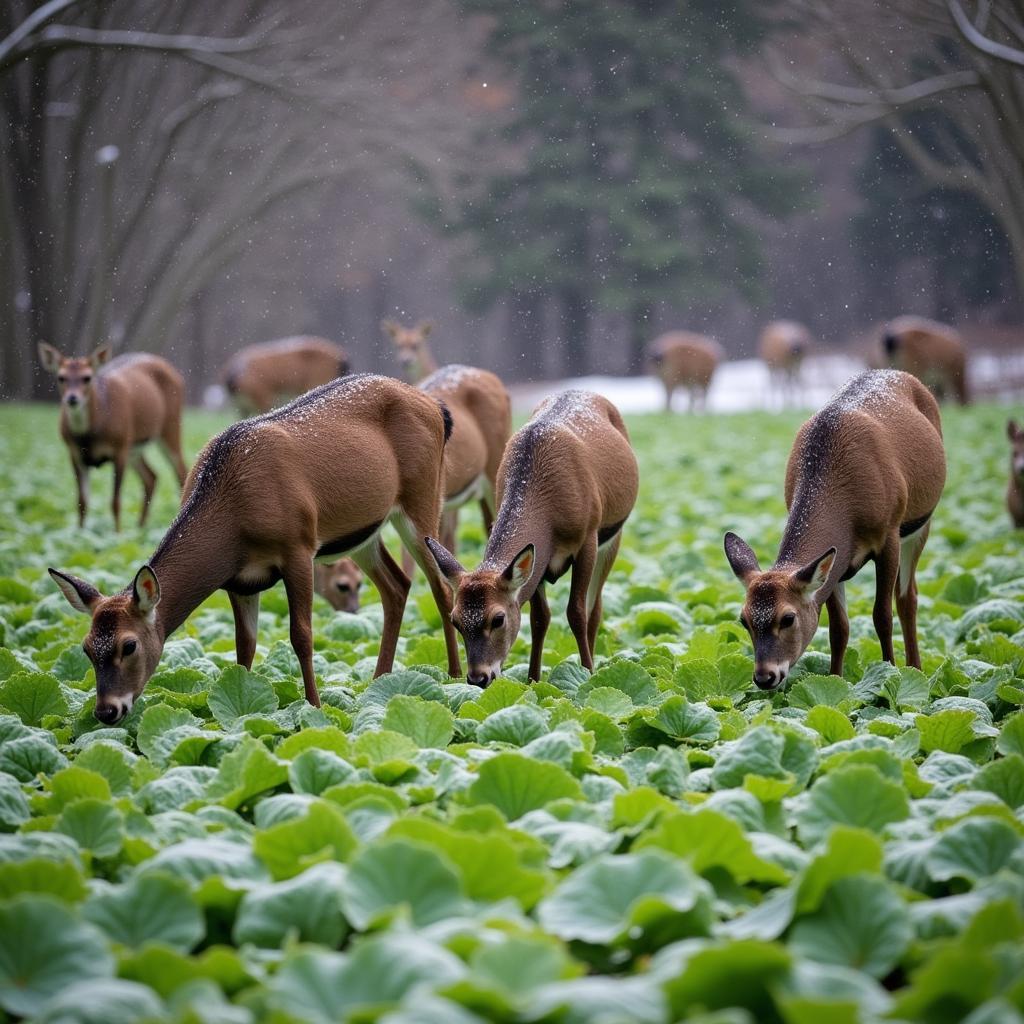Wildlife Food Plot Seed is the cornerstone of successful habitat management and hunting strategies. Understanding the nuances of different seed types, planting techniques, and regional considerations is essential for attracting and sustaining healthy wildlife populations. Whether you’re a seasoned hunter or just beginning your journey into wildlife management, this comprehensive guide will equip you with the knowledge to create thriving food plots that benefit both the animals and the environment. Let’s dive in and explore the world of wildlife food plot seed, from selecting the right mix to reaping the rewards of a flourishing ecosystem. You can enhance your winter food plots with specific seeds like winter food plot seed.
Understanding Your Wildlife Food Plot Seed Options
The vast array of wildlife food plot seed options available can be overwhelming. Each seed type offers unique benefits and caters to different wildlife species and environmental conditions. Broadly, wildlife food plot seeds can be categorized into cool-season and warm-season varieties. Cool-season seeds thrive in spring and fall, providing crucial forage during periods when other food sources may be scarce. Warm-season seeds, on the other hand, flourish during the summer months, offering vital nutrition when the weather is hot and dry.
Matching Seed to Species and Season
When choosing wildlife food plot seed, consider the specific animals you want to attract. Deer, for instance, are drawn to legumes like clover and alfalfa, while turkeys prefer grains like corn and milo. Also, factor in the local climate and soil conditions. Some seeds are more tolerant to drought or poor soil drainage than others. Choosing the correct seed for your needs is the first step to a thriving food plot. Chicory food plot seed is an excellent choice for attracting deer.
Brassicas, such as turnips and radishes, are highly attractive to deer during the late season. Their high nutritional value and palatability make them a valuable addition to any winter food plot. Understanding the specific needs of your target species is key to a successful wildlife food plot.
 Deer Enjoying Brassicas in Winter Food Plot
Deer Enjoying Brassicas in Winter Food Plot
Preparing the Land for Wildlife Food Plot Seed
Proper land preparation is crucial for successful germination and growth. This involves testing the soil pH and nutrient levels, clearing any existing vegetation, and tilling the soil to create a suitable seedbed. Consider adding lime or fertilizer to amend the soil based on the test results.
Effective Planting Techniques for Wildlife Food Plot Seed
The planting method you choose depends on the type of wildlife food plot seed and the terrain. Broadcasting, drilling, and no-till planting are common techniques. Broadcasting spreads the seed evenly over the prepared area, while drilling places the seed at a precise depth and spacing. No-till planting involves sowing seeds directly into the existing vegetation without tilling, which can be beneficial for erosion control. Food plot sunflower seeds can easily be broadcasted for attracting various bird species.
Ensuring proper seed-to-soil contact is essential for germination. This can be achieved by lightly raking or rolling the area after broadcasting or using a cultipacker after drilling. Maintaining proper moisture levels is also crucial during the early stages of growth.
Maintaining and Monitoring Your Wildlife Food Plot
Once your wildlife food plot is established, regular monitoring and maintenance are essential to ensure its long-term success. This includes controlling weeds, fertilizing as needed, and ensuring adequate water supply. Observing the wildlife activity in and around the food plot can provide valuable insights into its effectiveness and inform future planting decisions.
Maximizing the Benefits of Your Food Plot
Strategic placement of your food plot can enhance its attractiveness to wildlife. Consider creating multiple smaller plots rather than one large one, offering diverse food sources and cover. Clover seed for food plots provides an excellent source of nutrition and attracts a wide range of wildlife.
Integrating your food plot with other habitat management practices, such as creating brush piles or planting trees, can further enhance its value for wildlife.
Conclusion
Selecting the right wildlife food plot seed is paramount for successful wildlife management. By carefully considering the target species, season, and environmental conditions, you can create a thriving ecosystem that benefits both the animals and the environment. With proper planning, planting, and maintenance, your wildlife food plot will become a valuable asset for attracting and sustaining healthy wildlife populations for years to come. Remember that understanding your wildlife food plot seed options is crucial.
FAQ
- What is the best wildlife food plot seed for deer?
- When is the best time to plant wildlife food plot seed?
- How much wildlife food plot seed do I need per acre?
- What are the different types of wildlife food plot seed?
- How do I prepare the land for planting wildlife food plot seed?
- How do I maintain my wildlife food plot?
- Where can I buy wildlife food plot seed?
For further information, check out our guide on 7 card stud food plot seed. For any assistance, please contact us at Phone Number: 02437655121, Email: minacones@gmail.com or visit us at 3PGH+8R9, ĐT70A, thôn Trung, Bắc Từ Liêm, Hà Nội, Việt Nam. We have a 24/7 customer support team.